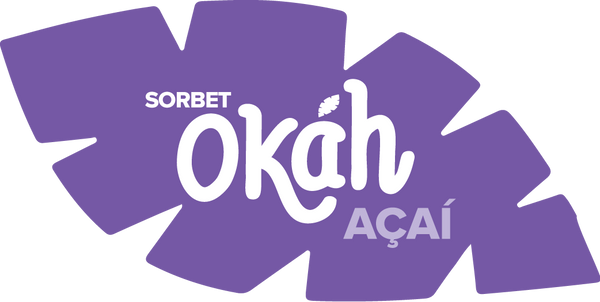
Do açaí bowls have milk? Unpacking the base ingredients
It seems like you can prepare an açaí bowl in more ways than you can count. You see them piled high with fresh fruit, crunchy granola, seeds, nuts, drizzles, and so much more, not even taking into account all the sugary treats they might come with.
Açaí bowls are a canvas for human creativity, a vibrant explosion of colours and textures that cater to almost any taste. It’s no wonder they’ve captured our imaginations and our appetites!
But, when you’re faced with this delicious creation, especially if you're trying to meet dietary needs or just understand the core ingredients, you might ask: do açaí bowls have milk?
Throughout this article, you’ll learn whether they have milk, the most common liquids you’ll see blended along with the pulp, and some dairy-based products you can use to decorate your bowl. Let’s unpack everything below!
So, do açaí bowls have milk?
Traditionally, or in their purest form, açaí bowls do not have milk as a core ingredient. The foundation of an açaí bowl is primarily made from frozen açaí pulp blended with a very small amount of liquid.
The signature thick, creamy, and frosty texture doesn’t come from milk; instead, it comes from the açaí pulp itself - and is often helped along by other frozen fruits (like bananas).
However, milk – whether dairy or a plant-based alternative – is commonly used as that minimal liquid ingredient that helps the blender process the frozen components.
So, while it's not a defining characteristic, it's present in many recipes as a blending aid or for added creaminess to your base.

What liquids are typically used in an açaí bowl base?
When you're blending up that thick açaí base, pay attention to the type and amount of liquid you use. The usual goal is that well-known perfect and spoonable consistency, not a drinkable smoothie. This means the liquid has a supporting role, acting more as a lubricant for the blender blades than a primary flavour or texture component.
The mantra here is: use minimal liquid! Too much will instantly turn your thick base into a runny smoothie. Ideally, you’ll start with a single tablespoon or two, and only add a tiny bit more if absolutely necessary to get things moving.
So, what are the common liquid choices?
Water is the simplest and often the best choice if you want the pure flavour of the açaí and your other toppings to shine through without any added taste. It’s neutral, calorie-free, and lets the açaí itself be the star.
Coconut water is another popular option. It adds a subtle, refreshing tropical flavour that complements the açaí well, and it also brings electrolytes, making it a good choice if you're making a bowl post-workout.
Plant-based milks, like almond milk, oat milk, soy milk, and cashew milk, are all excellent choices. They help to create a smoother, creamier texture than water alone and add their own subtle flavour notes that can complement the bowl beautifully. Many people prefer these for the added richness they provide.
Dairy milk is sometimes used, though it's perhaps less common in the purest, most health-focused açaí bowl recipes. If you prefer dairy or want a creamier texture, it can certainly be used, though plant-based alternatives are often favoured for their neutral or complementary flavours.
The main job of this liquid is simply to help your blender work its way through the frozen mass of açaí and fruit.
Starting with high-quality frozen açaí pulp, like the pure, unsweetened kind offered by suppliers such as Okah Superfoods, is really helpful because it means you often need even less liquid to achieve that perfect thick consistency, ensuring your base stays truly spoonable!

Milk in the toppings and other typical additions
While milk isn't a core ingredient in the blended base for most açaí bowls, it can appear in other ways, either as a topping or in different preparations of açaí.
For instance, in some more indulgent versions, like those you’ll usually see in ice cream parlors, you might find sweetened condensed milk drizzled over the top. This adds a significant amount of sweetness and richness, turning the bowl into more of a dessert. It’s definitely a treat, but it’s important to be aware of the added sugars if you're aiming for a health-focused meal.
You might also see milk or dairy products used in other açaí preparations that aren't the typical bowl. For example, if someone is making an açaí smoothie that’s meant to be drunk, like a smoothie, they might use a larger amount of milk or a dairy-free alternative to achieve a more drinkable consistency.
Ultimately, people are free to add what they like to their açaí bowls, and personal preference plays a big role.
If someone really enjoys a creamier blend and finds that dairy milk or a specific plant-based milk helps achieve their desired texture and taste, they might choose to add it.
However, no, milk is not an essential component for a great açaí bowl.

Far beyond the bowl: other ways to enjoy açaí
While the açaí bowl is the most famous way we see this fruit prepared, açaí pulp is surprisingly versatile. Thinking beyond just the standard bowl opens up new possibilities for incorporating this superfruit into your diet.
To start, açaí is fantastic in smoothies. If you prefer a more drinkable consistency, blending frozen açaí pulp with your choice of liquid, some other fruits, and maybe a scoop of protein powder or nut butter makes for a filling and nutrient-packed drink. It’s a quick way to get those açaí benefits without needing to focus on the perfect thick base.
Açaí powder, which is made from freeze-dried frozen açaí pulp, is another incredibly convenient option. This powder is super concentrated and can be easily stirred into things like yogurt, oatmeal, or pancake batter.
It adds that distinct açaí flavour and a nutritional boost without requiring freezing or blending. It’s perfect for travel or when you just want a quick flavour addition.
If you're feeling a bit more adventurous, you can also use açaí’s pulp in raw desserts. Blended with dates, nuts, and other flavourings, it can form the base for dairy-free cheesecakes, energy balls, or popsicles. The naturally thick and cold consistency is perfect for creating satisfying, healthy treats.
Closing thoughts
To close it off, let’s recap our initial question: do açaí bowls have milk? Not necessarily, and certainly not as a core defining ingredient. The base of a traditional and most popular açaí bowl is made from frozen açaí pulp blended with a very minimal amount of liquid!

While milk can be used as that blending liquid for extra creaminess or flavour, it’s not a requirement. Options like water, coconut water, and a variety of plant-based milks are commonly used and work beautifully. You’re usually going to see milk, particularly sweetened condensed milk, used as an occasional topping in more indulgent recipes, though.
Ultimately, the choice of liquid and toppings is yours to make, depending on your taste and dietary needs. The most important thing for a great bowl is starting with high-quality, pure frozen açaí pulp.
Ready to create your perfect açaí bowl, whether you choose to use milk or a dairy-free alternative? It all begins with getting that essential, high-quality frozen açaí base.
For premium, pure, and responsibly sourced frozen açaí pulp in the UK, look no further than Okah Superfoods. We provide the ideal ingredient to pair with your favourite liquid and toppings, helping you create delicious bowls exactly how you like them. Check out our range and get blending!



